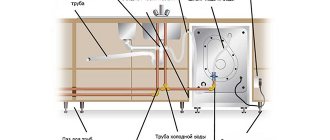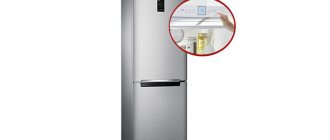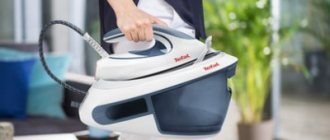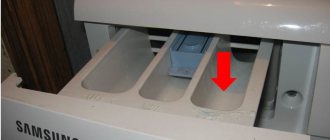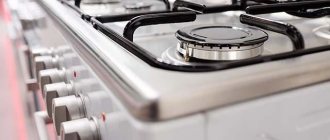Convection in Latin means “transfer.” In this case, it is the exchange of hot and cold air in the oven. In other words, the hot air flow rises to the top, and the cold air flows down. After some time, the temperature throughout the oven becomes the same.
In almost all old ovens, convection was “natural”, that is, heat exchange occurred, but it took a very long time. Housewives had to pull out a sheet of food and turn it over so that the dish would bake evenly. With meat dishes, such manipulations took place without consequences, but baking a high-quality sponge cake or meringue was almost impossible. Now, many ovens have “forced” convection; baking anything has become much more convenient, since the air is distributed evenly.
Principle of operation
Convection in the oven is carried out thanks to a fan installed in it. Its usual location is the back of the oven wall, from where it disperses the air inside. Its task is to achieve the required temperature. After the task is completed, the fan turns off.
Convection can be used in both electric and gas ovens. The advantages of gas ones are that they consume much less electricity. The main heating is carried out from below, so convection in such models is extremely necessary.
First impressions
The appearance of the Candy oven is fashionable: stainless steel finish, clean lines, wide geometric handle, large display, recessed switches, double-layer glass on the door.
The sharp corners on the handle were a little alarming: while cooking, sometimes you rush around the kitchen and you can get caught on a corner. So far, however, he has managed without bruises on his legs, so maybe these are empty fears.
Designation of convection modes
You can usually see the oven modes on the control panel. Convection itself is indicated by a fan icon, and there may also be additional functions. Eg:
- A horizontal line below the fan means bottom airflow
- Top line - top blowing
- Bottom and top line - simultaneous top and bottom blowing
- With a zigzag on top means airflow and grill mode
- Fan icon with "Eco" label listed as humid convection
Control Panel
Two recessed switches , between them there is a display with a clock and touch buttons of the programmer, next to the mode switch there is a backlit steam activation button - that’s all the control.
Mode switch with graphic symbols - everything is clear, although personally I’m used to other icons. The switches rotate freely both clockwise and counterclockwise and are easy to set in the desired position. They “recess” both when the oven is turned off and when it is on. Modes with steam have a special designation, and they can be used without steam; to activate this function, you need to press the button next to the regulator.
But the temperature regulator confused me a little; the temperature is indicated there like this:
50, “droplets” (Aquactiva function), 125, 150,175, 200 and Max.
But between 50 and 125 there are 4 divisions, then up to 200 degrees there is one division between the numbers, from 200 to the maximum there are 4 divisions.
Of course, I’m still a mathematician, and maybe that’s why I couldn’t determine the price of one division, so the maximum oven temperature remained a mystery to me - 250 or 275 degrees? The instructions also do not contain these values.
Wet convection mode
An oven with this mode is simply a real find for those who are in favor of proper nutrition. After all, in this mode you can prepare many different delicious and dietary dishes. The principle of its operation is that dishes are prepared by being evenly blown from all sides with moist hot steam. This affects cooking time and food quality. Steam is created due to the fact that such ovens have special built-in containers into which clean water is poured. As a result, the dishes are tasty, juicy, not overdried, and most importantly, all vitamins are retained.
Gorenje oven modes
The Slovenian company Gorenje is one of the leading companies producing household appliances. Operating on the market for almost 70 years, it has undoubtedly won the trust and love of customers with the excellent design, quality and functionality of its products. Its products have spread to Europe, America, and Asia. As Gorenje grew larger, it built its factories abroad, but no matter where its products are produced, the quality remains consistently high. Compared to the products of other manufacturers, Gorenje, first of all, stands out for its unique design, created by an Italian design studio. But this does not prevent her from constantly and purposefully technically improving her household appliances, including ovens. Both built-in and free-standing - they are all works of technical art.
Gorenje oven modes
Gorenje ovens are in such great demand not only for their beauty, but, of course, also for their quality and the ability to cook in different modes. In addition to the basic operating modes, different models have a number of additional functions. And the more modern the model, the more there are. Here are the main cooking modes in electric ovens.
- Classic heating (200 °C). With classic heating, two heating elements (heaters) are turned on: at the top and bottom of the oven chamber. Using this mode, you can cook almost any dish - from deli meats to cakes and pies, but only at a medium level.
- Bottom heating (160 °C). Only the bottom heater is activated. Recommended for dishes with a long cooking time. Well suited for one large product if placed on a medium level.
- Top heating (150 °C). Only the upper heating element is turned on. This mode is useful when the dish is almost ready, but the desired golden brown crust is not yet on it. Vegetables, cakes, and puddings are cooked by heating from above.
- Grill (240 °C). The central infraheater is heating up. Needed for preparing small portions of dishes. This way you can cook at a moderate temperature, which saves energy.
- Large electric grill (240 °C). The upper heating element and the infraheater in the form of a large powerful frame are turned on, which seals the product with hot air, then the juice almost does not flow out, and with a crust formed, the product inside remains tender. On the large grill you can cook good cuts of meat and kebabs.
- Large grill + fan (170 °C). Essentially the same large grill, but thanks to the fan built into the back wall, you can evenly cook large pieces of food without even turning them over.
- Ventilation heating / convection (150–190 °C). The ring heating element and fan operate. The heated air quickly spreads throughout the chamber, creating the same temperature everywhere, which means that the food will be evenly heated from all sides. This mode is good for cooking pies, pork trotters, cakes, roasts and any other foods. With convection, you can cook on several levels at once, and everything will be cooked equally. Use it to defrost food. This mode helps save time and electricity.
- Bottom heating + fan (180 °C). The operation of the fan is added to the operation of the lower heater. The cooking process goes faster. It is recommended to cook open pies with it. The bottom of the pies will be crispy and the filling will not dry out. It is not recommended to cook in pans with large sides. It is also used for canning. Use the first and second levels of the camera.
- Top heating + fan. The top heater operates and is supported by a fan. This mode allows a crispy crust to form on top while heating the rest of the dish evenly. The process of working with a fan is much shorter than without it. Used for casseroles, meat, lasagna and other dishes.
- Bottom heating + fan heating (160–200 °C). The ring and bottom heating elements are activated, the fan supports operation. In this mode, baked goods from cottage cheese, fruit cakes made from shortcrust pastry, and pizza are prepared.
- Fast oven heating. In fact, all heating elements work. Designed to heat an empty oven to a temperature set by the user. The oven heats up to 150 degrees in a couple of minutes, using minimal electricity. You can quickly preheat the oven and then cook at the desired setting or use it to cook frozen foods.
- Defrosting. Only the fan works. It is used for gradual complete or partial defrosting of various products: meat, fish, fruits, vegetables, cakes.
- Eco cooking. A ring heater with fan support operates. The oven heats up to 210 degrees, the air washes over the product being cooked. Mostly meat and pies are baked in this mode.
- AUTObake, automatic cooking. The oven program currently has a little less than ninety cooking recipes. If you select the quantity of your products, frying and the end time of the process on the display, the oven will prepare the dish without your participation.
- Canning. This process is possible provided you have both glass jars and glass lids for them. Pour approximately one liter of hot water (70 °C) into a baking tray with high sides and place 6 jars in it with the lids tightly closed so that they do not touch. When the liquid in the jars begins to bubble and boil, you can remove the jars. The conservation mode greatly simplifies and facilitates the work of preparing for the winter.
After cooking, the oven may become dirty with grease drips and food particles. To clean the device, pour water into a deep container and turn on the lower heating element. After half an hour, the oven is opened and wiped with special napkins.
Gorenje always improves proven classic oven operating modes and constantly develops new ones, making routine household work easier.
Advantages of convection ovens
Undoubtedly, ovens with a similar mode have a lot of advantages. In such cabinets you can prepare many different dishes, and even use them as a sterilizer.
Pros:
- Even distribution of air throughout the oven
- Ability to cook several dishes at once
- Minimum gas and electricity consumption
- Additional modes such as drying, defrosting
This mode can be used for drying fruits, nuts, meat, and crackers. You can also use it to defrost food. If you turn on the convection 15 minutes before the dish is ready, it will be covered with a golden crust.
Steam
Water needs to be poured directly onto the bottom of the oven , there is a recess there, but it is small, and if the oven is not very level, then the water simply spills over the entire surface.
The instructions limit the volume of water - 300 ml; adding water during cooking is not recommended.
Therefore, it is important to turn on the steam function already when the oven has heated up to the set temperature . This somewhat limits cooking when programming time: steam is turned on automatically when the mode is turned on, and the water will begin to evaporate faster.
Of course, such a small volume of steam does not allow it to be fully used, especially if the dish is cooked for longer than 40 minutes. But it plays its role, as I was convinced of while cooking.
Functional
My children dubbed the month of dough the month of pizza : we used the “Italian” program to the fullest.
We prepared pizzas large and small, on thick bases and on thin wheat flatbreads, using proven recipes and experimenting with different flavors.
Excellent program: the pizza is of the highest quality!
During operation of this mode, convection is intensively used (the fan rotates so that the pizza dish bounces on the grill). Everything is baked evenly, the cheese melts but does not burn. We liked!
And, of course, I actively used steam programs .
Still, when baking fish and when preparing pastries such as strudel, steam is the best assistant. The fish does not dry out and turns out more juicy.
Puff pastry under the influence of steam becomes more airy, and at the same time soft. Those 15-20 minutes of active steam generation are, in principle, enough to saturate the dish, but it’s a pity that you can’t add water, because when baking, for example, a turkey, 300 ml of water for steam is clearly not enough.
I liked cooking in the Candy FCPS815XL : the oven heats up very quickly, heats up evenly, there are a variety of modes , allowing you to cook any type of food . In addition, the oven can be used to rise dough (fan +50 degrees) and to prepare yogurt. I can imagine how many more delicious things we have ahead of us: the plans include “Anna Pavlova”, meat pies, casseroles and moussaka, creme brulee and profiteroles, and, of course, pizza, pizza, pizza.
Care
If you use unfiltered water, whitish marks will remain on the bottom of the oven after cooking . They can be immediately wiped with a damp cloth and are easily removed. Once every few months, you can use a citric acid solution or vinegar for cleaning.
The same steam will help clean the interior of the oven.
The Aquactiva function provides heating for 30 minutes, during which time the steam will soften all dirt on the oven walls and make cleaning easier.
Characteristics
Modes : 8 – defrosting, fan cooking, grill + convection, convection + bottom heating element, traditional (top + bottom), grill, pizza, Aquactiva.
Modes with steam: convection + steam, grill + convection + steam, grill + steam.
Temperature range : from 50 to 275 degrees.
Volume : 70 l.
Class : energy efficiency A.
Controls : recessed rotary temperature and mode switches, steam button, LCD display, clock; protection from children; programming cooking time and end of cooking.
Care : Aquactiva steam cleaning system, easy-to-clean enamel.
Equipment : a pair of telescopic guides, a metal grid, a deep baking tray.
Dimensions : 595x595x568 mm . Niche : 590x560x560 mm.
Warranty : 1 year.
Country of origin : Turkey.
Price : 25990 rub.
Features of the mode in gas-powered equipment
A gas convection oven scares many people. Users fear that air movement will extinguish the fire. However, according to manufacturers, such devices are completely safe, because they are equipped with special hollow burners, as well as a function that blocks the operation of the device in the event of danger. The special fan in this unit is designed taking into account the characteristics of this type of oven.
It is more difficult for a gas-powered appliance to achieve uniform distribution of hot air due to the fact that the burner is only located at the bottom. Before placing the dish you are preparing in the oven, you must wait for the heat to be evenly distributed around the entire perimeter, that is, after turning on the oven you should wait a while.
A characteristic feature of such devices is energy savings, as well as a relatively high price, which, by the way, will very quickly pay for itself through the use of gas. In addition, purchasing this model does not require particularly powerful wiring in the house.
The BOSCH HGN22F350 model is a good example of a convenient and reliable gas oven equipped with a convection heating mode. The device is quite spacious, the useful volume is 60 liters. This unit, in addition to preparing all kinds of dishes, will do an excellent job of defrosting food. The presence of a gas control system guarantees safe use of the device and adds confidence to a person’s personal security. In addition to the listed useful features, this model has an attractive design.
Types of convectors
Oven manufacturers are constantly working to improve fans. After all, such a seemingly insignificant detail plays an important role in cooking, speeding up and facilitating the process.
Convection types:
- the heating circuit is used to quickly heat the air;
- hot air generated by the fan heats the cabinet at an accelerated pace, and is an ideal solution for quickly cooking food;
- moist convection will be appreciated by supporters of proper nutrition, connoisseurs of healthy dishes, and food cooked in the “steamer” mode.
Depending on the energy consumed, location and design features, convection ovens are:
- gas and electric;
- free-standing or built-in;
- working autonomously or connected to the hob;
- mini-ovens resembling small microwaves.

